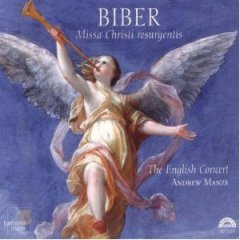Biber - Missa Christi Resurgentis (2005)
Biber - Missa Christi Resurgentis (2005)

1. Fanfare No. 4 à due (from Sonatae tam aris quam aulis servientes, 1676) 1:55 2. Missa Christi resurgentis: Sonata 1:16 3. Missa Christi resurgentis: Kyrie 3:10 4. Missa Christi resurgentis: Gloria 8:56 5. Sonata à 6 (c. 1673) for trumpet, 2 violins, 2 violas & bass 7:09 6. Missa Christi resurgentis: Credo 11:20 7. Sonata XII (from Sacro-profanus concentus musicus, 1662) 4:39 8. Missa Christi resurgentis: Sanctus 4:39 9. Sonata XI (from Fidicinium Sacro-profanum, 1682) 6:08 10. Missa Christi resurgentis: Agnus Dei 4:14 11. Fanfare No. 1 à due (from Sonatae tam aris quam aulis servientes, 1676) 1:31 12. Sonata I (from Fidicinium Sacro-profanum, 1682) 7:37 13. Sonata V (from Fidicinium Sacro-profanum, 1682) 3:58 14. Sonata III (from Fidicinium Sacro-profanum, 1682) 5:09 15. Sonata VII (from Fidicinium Sacro-profanum, 1682) 5:44 Michael Harrison (Trumpet) Mark Bennett (Trumpet) Andrew Manze (Violin) English Concert, English Concert Choir Andrew Manze – conductor
The music on this disc is about sonority, about the brilliance of trumpets and strings in a live, reverberant acoustic such as that of Salzburg cathedral, for which at least some of these works were conceived. And Andrew Manze and his English Concert unequivocally deliver (albeit in the less-opulent confines of London's Temple Church), from the opening fanfare through the vibrant, tuneful, richly scored sonatas that periodically spice this thoughtfully organized program. The featured work is a Mass, the Missa Christi Resurgentis, likely written for Easter in 1764. It's a lavish celebration scored for two four-part choirs, an added bass singer, plus two instrumental ensembles, designed to be performed antiphonally in a grand display. Here, Andrew Manze enhances the work with authentic touches, such as opening and closing trumpet fanfares and instrumental "sonatas" interspersed throughout. In fact, it's these instrumental pieces--including the four Sonatas at the end of the program--that really demonstrate the brilliance and beauty of Biber's compositional skill, his command of "sonority" and how to maximize its effect in a large acoustic space.
I'm not as wild about the choral writing, which too often relies on pat imitative devices--try the opening minutes of the Gloria, for instance--and formulaic rhythmic/harmonic schemes to advance or to illustrate the text--again, the Gloria provides ample evidence during its first six minutes. In addition, the voices, which use full vibrato technique throughout, tend to become lost in the texture when the orchestra joins them--and it's the scoring, not the recording that's responsible. Consequently in many of the tutti sections the singers seem to be trying to compensate by maintaining an aggressively loud dynamic (sections of the Sanctus, for example). However, there is an odd perspective regarding the two choirs--they appear too close, at least for my listening comfort, both to the microphones and to each other, especially if the intended effect is of antiphonal "dialogue".
Keeping with the style of the time and place, Manze inserts an instrumental Sonata (trumpet, two violins, two violas, and bass) following the Gloria, and it's a wonderful, uplifting, exciting seven minutes. Manze's violin is never far away (there are a couple of interesting violin duets in the Mass), and there are nice bits from trumpets and harpsichord. Sonatas also come after the Credo and Sanctus, and as mentioned, the disc closes with four more. They're all expertly scored, and the recording fully exploits the richness of tone and timbre of the brass and strings. While the Mass certainly is a magnificent work--and I'm sure it's most impressive if heard live--if you want to experience some fine instrumental music from one of the Baroque's great composers, don't let this one get away. --- David Vernier, ClassicsToday.com
download: uploaded anonfiles mega 4shared mixturecloud yandex mediafire ziddu
Last Updated (Monday, 26 August 2013 14:07)








